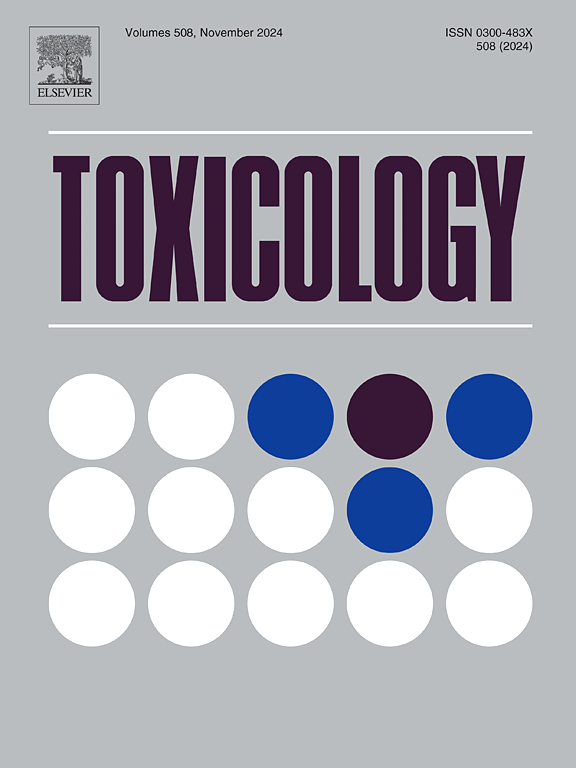毒死蜱在三阴性乳腺癌模型中诱导肺转移和肿瘤干细胞标志物的调节
IF 4.8
3区 医学
Q1 PHARMACOLOGY & PHARMACY
引用次数: 0
摘要
乳腺癌是一个重大的公共卫生问题,远处转移是发病率和死亡率的主要原因。毒死蜱是一种有机磷酸盐,可促进乳腺癌细胞系上皮-间充质转化样表型,并调节乳腺癌干细胞激活与转移级联相关的两个关键过程。在这里,我们研究了毒死蜱是否会在体内三阴性肿瘤模型中诱导远处转移。此外,我们还研究了乳腺癌干细胞和上皮-间充质转化激活标志物在三阴性乳腺癌小鼠肿瘤和人细胞中的表达。我们证明毒死蜱在单层或三维培养中调节干细胞可塑性作为生长条件的功能。毒死蜱可缩短小鼠的倍增期,增加肿瘤体积,刺激邻近肌纤维浸润,诱导肺和淋巴结转移。最后,毒死蜱对暴露于农药的小鼠的上皮-间充质转化和BCSC标志物的表达进行了调节。我们所有的研究结果证实,毒死蜱在小鼠体内诱导的模型中促进乳腺癌进展,增强干性和上皮-间质转化标志物的表达,并产生肺转移。本文章由计算机程序翻译,如有差异,请以英文原文为准。
Chlorpyrifos induces lung metastases and modulation of cancer stem cell markers in triple negative breast cancer model
Breast cancer is a major public health problem, and distant metastases are the main cause of morbidity and mortality. Chlorpyrifos is an organophosphate that promotes Epithelial-Mesenchymal Transition-like phenotype in breast cancer cell lines and modulates the Breast Cancer Stem Cells activating two key processes related to the metastatic cascade. Here, we investigated whether Chlorpyrifos may induce distant metastases in an in vivo triple negative tumor model. Also, we studied the expression of Breast Cancer Stem Cell and Epithelial-Mesenchymal Transition activation-markers in Triple Negative Breast Cancer mice tumors and human cells. We demonstrate that Chlorpyrifos modulates stem cell plasticity as a function of growth conditions in monolayer or three-dimensional culture. Furthermore, Chlorpyrifos decreased the doubling period, increased tumor volume, stimulated the infiltration of adjacent muscle fibers and induced lung and lymphatic node metastases in mice. Finally, Chlorpyrifos modulated the expression of Epithelial-Mesenchymal Transition and Breast Cancer Stem Cell markers in mice exposed to the pesticide. All our findings confirm that Chlorpyrifos promotes breast cancer progression, enhances stemness and Epithelial-Mesenchymal Transition marker expression and generates lung metastases in an in vivo model induced in mice.
求助全文
通过发布文献求助,成功后即可免费获取论文全文。
去求助
来源期刊

Toxicology
医学-毒理学
CiteScore
7.80
自引率
4.40%
发文量
222
审稿时长
23 days
期刊介绍:
Toxicology is an international, peer-reviewed journal that publishes only the highest quality original scientific research and critical reviews describing hypothesis-based investigations into mechanisms of toxicity associated with exposures to xenobiotic chemicals, particularly as it relates to human health. In this respect "mechanisms" is defined on both the macro (e.g. physiological, biological, kinetic, species, sex, etc.) and molecular (genomic, transcriptomic, metabolic, etc.) scale. Emphasis is placed on findings that identify novel hazards and that can be extrapolated to exposures and mechanisms that are relevant to estimating human risk. Toxicology also publishes brief communications, personal commentaries and opinion articles, as well as concise expert reviews on contemporary topics. All research and review articles published in Toxicology are subject to rigorous peer review. Authors are asked to contact the Editor-in-Chief prior to submitting review articles or commentaries for consideration for publication in Toxicology.
 求助内容:
求助内容: 应助结果提醒方式:
应助结果提醒方式:


